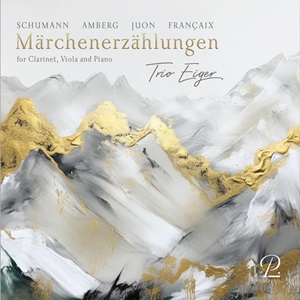
Märchenerzählungen (Fairy Tales) for Clarinet, Viola and Piano
Paul Juon (1872-1940)
Trio-Miniatures, Opp 18a, 24a (1920)
Johan Amberg (1846-1928)
Fantasistykke (Fantasy Pieces), Op 12 (1910)
Robert Schumann (1810-1856)
Märchenerzählungen (Fairy Tales), Op 132 (1853)
Jean Françaix (1912-1997)
Trio (1990)
Trio Eiger (Filipa Nunes, clarinet; Maria Clément, viola; Kateryna Tereshchenko, piano)
rec. 2023, Konzertsaal, Landenberghaus, Greifensee, Switzerland
Reviewed as a 24-bit/96kHz press download
Prospero PROSP0084 [63]
This enterprising release from the Swiss label Prospero encompasses works dating from the early 1850s to 1990 by composers from Russia, Denmark, Germany and France. The common thread is that they were written for the unusual combination of clarinet, viola, and piano. Mozart’s trio in E-flat major (incorrectly dubbed the Kegelstatt (or bowling alley) was the first and arguably most famous work for these instruments, but it was hardly the last.
The program is anchored by the Juon and Amberg works, composed ten years apart in the early 20th Century. Born Pavel Fyodorovich Yuon in Moscow, Paul Juon studied composition first at the Moscow Conservatory and then in Berlin. After briefly teaching composition in Baku, he returned to Berlin. There he held a professorship at the Academic College of Music (now part of the Berlin University of the Arts), where his many composition students included such notables as Nikos Skalkottas and Stefan Wolpe. In 1930, he “retired” and moved to Vevey, on Lake Geneva, but he continued composing.
Juon’s musical idiom is closer (though with less bravura) to that of his Belle Époque contemporary Rachmaninov than to that of pioneers and iconoclasts born in the same decade, such as Ravel, Scriabin, and Schoenberg. Reynaldo Hahn, also born in 1872, is an apt comparison, with similarly deft use of harmonic colour and a knack for memorable ideas and gestures. The four Trio-Miniatures could be described as “salon music,” but this would not do justice to Juon’s vivid inspiration. I especially enjoyed the first of the four, Rȇverie, which starts with a brief, exquisite piano solo before the successive entries of viola and clarinet. The last of the four, Danse phantastique, is an utterly charming waltz.
Although born a quarter-century before Juon, Johan Amberg did not begin composing in earnest until his late fifties, after several decades as a violinist in the Royal Danish Orchestra. As a composer, he is thus a near-contemporary of Juon. On the evidence of these Fantasy Pieces from 1910, however, his style is decidedly more conservative than Juon’s. The first piece is dedicated to the memory of Robert Schumann, and indeed this music is rather like that of Schumann or Brahms. If not at the same level of inspiration or impetus, it has its moments. In their antiquated way, the Fantasistykke have charm.
Amberg has languished in almost total obscurity. Neither Danacord nor Dacapo has ever issued a performance of his music, and this release might be the first commercial recording of anything he wrote. For that reason alone, the inclusion here of the Fantasistykke is of value. Buy this disc, and you will be the only kid on the block whose collection includes Johan Amberg.
As it is the most recorded work on this release and was written by the most famous of these four composers, one might assume that Schumann’s Fairy Tales are the best music. Unfortunately, this is not Schumann at the top of his game. Rather, it is a very late work, written just a few months before his attempted suicide in February 1854, which put an end to his life’s work (though not his life). I was not familiar with this piece. Listening to it, one gets the uneasy sense that by autumn 1853, Schumann still knew how to compose but had lost confidence in what he had to say. The Eiger Trio’s performance is not to blame for this: I sampled other recordings (eg. the Nash Ensemble on Hyperion CDA67923; review), but found none that makes a significantly more persuasive case for this work.
The disc concludes with the 1990 Trio by Jean Françaix, a conventionally structured work in five movements: largo, allegrissimo, scherzando, largo, presto. A composer of great facility (Rossini as a 20th Century neoclassicist, if you will), Françaix could unspool one fluent, precisely structured passage after another. While rarely dull, at times his music can seem glib. For this listener, the most engaging sections of this piece are those —particularly in the two slow movements but elsewhere as well— in which the writing strays into slightly odd harmonies and closely spaced voicings for viola and clarinet, in a manner reminiscent of Charles Ives.
The Eiger Trio’s performance of the Françaix is beyond reproach: a carefully prepared and technically assured reading of a work considered to be really difficult. Precise characterization and technical command are no less evident in the other works, though these probably do not present similar challenges. To me, it is especially admirable that the clarinet is not placed in the foreground, as often happens in music of this kind (eg. Dimitri Ashkenazy et al. on Paladino PMR0074; review). The three musicians, working members of Zürich Opera’s pit orchestra (aka the Philharmonia Zürich), play as equal partners. Is that because none is a man? I dare not speculate.
Prospero’s recording, made in a beautiful private concert hall in Greifensee, near Zürich, is clear and truthful balanced. This disc is well worth acquiring for the Juon and Françaix pieces, while the Amberg is genuinely a rarity. The Trio Eiger (trans: Ogre Trio) take their name, I assume, from the Berner Oberland mountain with the frighteningly immense North Face. This is their debut recording. I hope we will have a chance to hear them in other works for their instruments —the Kegelstatt of course, but also major compositions of Reger and Kurtág.
Doug Barnes
Buying this recording via a link below generates revenue for MWI and helps us keep free access to the site


















